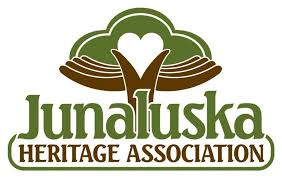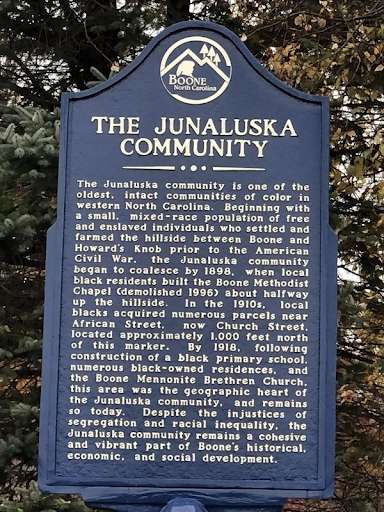Introduction
The Junaluska Story is a student-led research project that aims to improve awareness of the Junaluska neighborhood, one of Appalachia’s oldest African American communities. Advanced Placement US History students at Watauga High School researched different people, locations, and organizations associated with Junaluska using primary and secondary sources. We compiled our research and created the digital tour/history you see here. Our hope is to share information about this significant place and to celebrate an important piece of Watauga County’s history and present. Our project builds on and is informed by the decades of work by the Junaluska Heritage Association (JHA), scholars such as Dr. Susan Keefe, Dr. Andrea Burns, Dr. Kristen Baldwin Deathridge, and Dr. Alice Wright, and countless community members who are determined to preserve this history. Through this project, students have sought to honor the residents, past and present, of this vibrant Black Appalachian neighborhood.
A Brief History of Junaluska
The Junaluska Community is a historic Black neighborhood in Boone, North Carolina. No clear date has been determined for its establishment, but free Black people and enslaved people have lived in the area since the mid-1840s. The Junaluska Community is one of the few surviving historically Black communities in Western North Carolina.
Junaluska community members do not speak much about the history of slavery, but most current residents can trace their ancestry to enslaved people. When slavery ended following the Civil War, the number of free Black people in Junaluska grew. In 1850, 29 free Black people lived in the neighborhood, whereas by 1870 that number reached 210. The first people to live in Junaluska were farmers, often raising hogs and cultivating small house gardens.1
While the name ‘Junaluska’ is commonly used, current residents of the community are unsure about its origin. One explanation is connected to the nineteenth century leader of the Eastern Band of Cherokee in Western North Carolina named Junaluska. The title “Chief Junaluska” was sometimes used by Samuel Underwood, who lived on top of Howards Knob in Boone. Underwood had Cherokee ancestry and was himself an ancestor of some Junaluska residents. Another explanation is that the name comes from Junaluska Road, which is part of the community, built in 1905.2
The population of Junaluska has fluctuated significantly over the last 150 years. In 1890, 431 Black people lived in Junaluska, and the population fluctuated between 200 and 400 people throughout most of the 20th century. As the population of Watauga County grew between 1970 and 2010, so did the Black population. By 2010, 877 Black people lived in Watauga County, with 603 living in Boone. Despite this overall growth, the Junaluska population decreased throughout the 20th century. In 1942, Frazier Horton, a resident of the neighborhood, identified 191 Black people and 59 Black families in Junaluska. However, by 2013, only 97 black people remained living in the neighborhood.3 The decrease in the Junaluska population was largely due to people moving to take advantage of increased educational and employment opportunities elsewhere following the Civil Rights Movement and desegregation. In addition, the demand for housing and land in and around Boone has created a challenge to the cohesiveness of the historic community.4
During the early twentieth century, Junaluska remained mostly secluded, and residents relied on each other for everything but paid jobs. Many people were subsistence farmers, and the families shared excess food from their gardens with their neighbors, establishing close bonds between members of the community. Residents held large Sunday dinners with their neighbors and would invite other distant relatives to join them.5
Before the Civil Rights Movement, Black people in the Junaluska community were prohibited from all jobs other than manual labor, leading many men to work as cooks, construction workers, and dishwashers, while women worked as seamstresses, nannies, and housekeepers. Many residents created small businesses, often operating out of their homes. They were hairdressers, sold ice and fuel, and operated small grocery stores.6
Religion has played a major role in Junaluska. The Methodist Episcopal Church, built in 1898, was the first church in the neighborhood. The church was an integral part of the historic community culture.7 The Boone Mennonite Brethren Church was built and established by missionary Joseph Tschetter in 1918. The Mennonite missionaries and their Anabaptist Protestant beliefs combined with Black Appalachian culture to create a unique religious outpost in the neighborhood. While the Methodist Episcopal Church no longer exists, the Boone Mennonite Brethren Church has continued to serve the community.8
Education was, and is, very important to Junaluska residents. Black children were educated in private schools or churches long before public schools were established. In 1882, a school for Black children opened in Cove Creek. By 1900, three schools for Black students were operating in Cove Creek, Beaverdam, and Boone. The schools created educational opportunities for children living in the Junaluska community, and around the High Country. The public school system in Watauga County constructed two different school buildings in Junaluska. In 1937, the first Watauga Consolidated School was completed on Church Street. It was replaced in 1959 with a new building on Wyn Way in which the Black students of Watauga County were educated until the schools were fully desegregated in 1965.9
Today, the Junaluska Heritage Association (JHA) works to celebrate and preserve the unique history and tradition of the community. The JHA’s purpose is to “protect and preserve the historically black Junaluska neighborhood of Boone, NC, and to collect, curate, and celebrate the cultural heritage of its residents.” Over the years, the JHA has helped Junaluskans discover family genealogies and the history of the community and they founded a celebration known as the Junaluska Jubilee. The Junaluska Jubilee was held for several years and raised awareness and visibility of the black community in Boone.10
A Community Rich in Culture
The Junaluska Story may seem familiar on the surface: A Black community was isolated and segregated. Members of the community were able to survive and thrive through creativity, sharing among neighbors, and reliance on religious faith. While Junaluska bears some resemblance to Black communities elsewhere, its story is unique. The community’s Appalachian heritage, along with the strong influence of Mennonite Brethren theology, combined to give this community a rich and unique culture. Since the nineteenth century, Junaluska has persisted. Here, the residents have developed a cohesive, integrated, and hard working neighborhood, tucked away in the mountains of Boone, North Carolina. The community remains close knit and continues to share their story. Our hope is that this project will help amplify the voices of Junaluska as we seek to make the Junaluska story accessible to more people. While we highlight the history, Junaluska continues to change, grow, and have a positive impact on Boone and the High Country.

Junaluska Neighborhood Map
Susan E. Keefe and Ashley Brewer, “Junaluska Neighborhood Map,” Junaluska Heritage Association, accessed January 24, 2025, https://junaluskaheritage.org/document/53.

Junaluska Heritage Association Logo
Junaluska Heritage Association, https://junaluskaboone.org

Junaluska Historical Marker placed by the Town of Boone
Tracy Marsteller, “Junaluska Marker,” Junaluska Heritage Association, accessed January 24, 2025, https://junaluskaheritage.org/document/82.
Start Exploring
- Junaluska’s Impact at Appalachian State University
- The Boone Mountain Lions Baseball Team
- The Chocolate Bar
- Horton’s Ice and Coal Store
- Junaluska Gospel Choir
- Junaluska Park and North Street Park
- Boone Mennonite Brethren Church
- Boone Methodist Episcopal Church
- 1937 Watauga Consolidated School
- 1959 Watauga Consolidated School
- The Old Boone Cemetery
- Reverend Ronda Horton
- Desegregation of Watauga County Schools
Bibliography
Keefe, Susan, ed. Junaluska: Oral Histories of a Black Appalachian Community. Jefferson, NC: McFarland & Company, Inc. 2020.
-
Susan Keefe, ed., Junaluska: Oral Histories of a Black Appalachian Community, Jefferson, NC: McFarland & Company, Inc., 2020, 8-9. ↩︎
-
Susan Keefe, 9. ↩︎
-
Susan Keefe, 10. ↩︎
-
Susan Keefe, 11. ↩︎
-
Susan Keefe, 13-14. ↩︎
-
Susan Keefe, 14-15. ↩︎
-
Susan Keefe, 19. ↩︎
-
Susan Keefe, 22-24. ↩︎
-
Susan Keefe, 24-25. ↩︎
-
Susan Keefe, 28-29. ↩︎